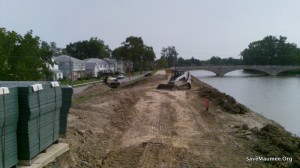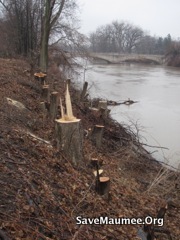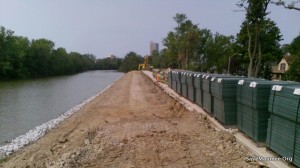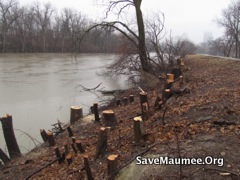Allen County Surveyors Office
On July 27, 2017, Allen County Drainage Board sided with protection of vegetation on a specific ditch that Save Maumee had restored with the help of 209 volunteers who logged over 1,387 hours over the month of April 2017. 2,500 miles of ditches in Allen County, which flow into The Great Lakes, are now afforded more protection because Allen County Drainage Board understood what Jeff Sorg, elected Allen County Surveyor, could not. Protect riparian buffers on ditches!
This issue is reflective of how environmental groups are moving to change a system that is bound by politics, which are now directly interfering with water quality. We all need to think about our responsibility to maintain these ditches and where that intersects with our responsibility to preserve natural spaces; and the understanding that clearcutting does neither. For years, people have called Save Maumee about the County removing trees on private property and adjacent ditches to their property. We now have a vested interest in undertaking this cause, making a stand and protecting our interests so future battles do not need to be waged by landowners.
This grassroots movement has been building, seemingly unnoticed, until now. Save Maumee Grassroots Organization Inc., a nonprofit 501 (c)(3) public charity has dedicated over 12 years to cleaning up the banks of the Maumee River and has worked to improve water quality with their shovel-ready projects. To date, the group has removed over 33,000 pounds of garbage from Fort Wayne waterways and raised awareness successfully. Over their 12th Annual Earth Day Celebration, Save Maumee planted 1,100 trees over three days in Trier Ditch of New Haven, Indiana. The Maumee River crosses all the political boundaries of the City of Fort Wayne, Allen County, and the State of Indiana, so the protection of the 2,500 stream miles that the Allen County Surveyor maintains is precedent-setting. Save Maumee’s projects will not only improve water quality, but will assure that the ditches flow properly and improve water for future generations.
Public Access Fort Wayne now covers the Allen County Drainage Board Meetings! THANK YOU PUBLIC ACCESS: CLICK FOR ALL MEETINGS
___________________________________________________
Press Release: September 19, 2017
Jeff Sorg, Allen County Surveyor, who reports to Allen County Drainage Board, thinks that access limited to one side of the ditch may result in increased maintenance fees for property owners who already pay drain maintenance fees. Save Maumee disagrees because this is simply not true in every case.
Celia Garza, Save Maumee Vice President, repudiates this claim saying, “It seems strange that fees would go up with preservation of native habitat on one side. This would equate to less work for contractors that mow or spray the ditches and less money spent on chemicals used to spray riprap. Decisions about vegetation removal should be made on a case-by-case basis. In general, people want trees on their property. Save Maumee also understands that the most easily accessible side should always be available to trucks for regular maintenance. Contrary to the Surveyor’s claims, the drainage law does not require all regulated drains to be void of vegetation on both sides. ”
Save Maumee’s President and Founder, Abigail King, knows that most landowners do not wish to see trees removed from their property. “The restoration projects the organization implements could save taxpayer money on 2,500 miles of streams. Trees on one side of most Allen County ditches will improve a range of issues like flooding, erosion, and stream bank degradation, and it will also improve habitat and aesthetics for recreational opportunities on our rivers. Support for this initiative is important because we can improve our shared waters all the way to Lake Erie.”
______________________________________
Great Lakes Water Quality Agreement, [Indiana] Domestic Action Plan for the Western Lake Erie Basin.
September 19, 2017
This document will be enhance a plan that includes 8 States and 2 Canadian Provences, all of which contribute water to The Great Lakes Watershed. Its purpose is to improve water quality.
SAVE MAUMEE’S COMMENTS HERE
_______________________________________
Army Corps of Engineers guidelines
Now, we are looking forward to understanding the process of riverbank vegetation removal…
1) Who gets to decide what trees and plants are removed?
2) Who gets to decide what native vegetation is appropriate and should not be removed?
3) Will “they” continue to spray the rip-rap (large rocks) with Rodeo (herbicide) twice per year even though the vegetation does not present an unacceptable safety risk?
This measure would prohibit “the removal of existing vegetation as a condition or requirement of any approval or funding of a project, or any other action, unless the specific vegetation has been demonstrated to present an unacceptable safety risk,” according to Indiana State Representative Marlin Stutzman. (Journal Gazette. Fort Wayne, IN. October 23, 2013)
4) What are the next steps to review riparian areas in Fort Wayne, to uphold this newly passed legislation?
U.S. Congress Levee Bill Overview
Update May 21, 2014 The BILL PASSED ~ YEAH!
SEC. 2020. VEGETATION MANAGEMENT POLICY
March 7, 2014
Indiana Federal Senator Joe Donnelly supports the Bill and his Office expects the Bill to be voted upon within the next 2 months. The Conference Committee Chair is California Federal Senator Barbara Boxer.
Indiana Federal Senator Dan Coats supports the Bill and his office expects the Bill to be voted upon within the next few months. “We are supporting the Bill, as long as there are not earmarks added that we do not agree with.”
I. January 27, 2014
The U.S. House of Representatives passed H.R. 3080, the Water Resources Reform and Development Act of 2013, on October 23, 2013. The U.S. Senate passed S. 601, the Water Resources Development Act of 2013, on May 15, 2013. The two chambers are now in the process of conferencing their bills.
II. Explanation of Legislative Process
Conference committees operate after the House and the Senate have passed different versions of a bill. Conference committees exist to draft a compromise bill that both houses can accept. Both houses of Congress must eventually pass the identical legislation for the bill to become law. The two houses can reach that identical product through the process of amendments between Houses, where the House passes the Senate bill with a House amendment, or vice versa, but this process can be cumbersome. Thus most major bills become law through using a conference committee.
III. Current practices of the Army Corps of Engineers document:
A. “Guidelines for landscape planting and vegetation management at levees, floodwalls, embankment dams and appurtenant structures. (ETL 1110-2-571)” DOWNLOAD HERE:
B. Background
1. ACE made a blanket statement for the entire USA due to the levee breech during 2009’s Hurricane Katrina in New Orleans, LA.
C. Rodeo (only DNR approved herbicide) broadcast spraying (rather than spot spraying) on ALL rip-rap (stones on the side of river) to keep any and all vegetation from growing, for inspection purposes only.
1. This continues to be a practice that should be reviewed in this study as well
D. In addition to the 2X/year vegetation removal ON the rip-rap, ACE is putting pressure on the Board of Public Works to remove more vegetation from stream banks in addition to the riverbanks that have already been rip-rapped.
E. ACE needs to define what they consider “water retention”.
1. Are these areas required to have a levee structure on it? Have natural alternatives been thoroughly researched by the Corps? Contradiction has been consistent throughout ACE’s history on such critical issues. Discussion on levee maintenance contradictions.
IV. Progression of the Bill
October 23, 2013 Legislation Introduced: Levee-clearing mandate challenged; Stutzman amendment halts arbitrary removal of trees unless the specific vegetation has been demonstrated to present an unacceptable safety risk
October 24th, Indiana Rep. Marlin Stutzman PASSED a bill that will halt the arbitrary removal of trees, helping to protect the natural spaces needed to filter water, retain native life, hold soil down and save Indiana taxpaying funds $25 million!
V. How Save Maumee helped this legislation to develop
It took many of us relaying facts about retaining natural unmowed spaces next to waterways to push this issue forward.
A. Rep. Stutzman was walked to his car by Abigail King at the Maumee Valley Heritage Corridor Annual Member Meeting, and informed him about levee & vegetation issues.
B. Indiana State Rep. Electoral Candidate Jack Morris is very aware of the issue, and has worked with Save Maumee and Win Moses to move this issue forward.
C. Bob Moris’ 15-year-old son was Abigail King’s drivers education student, so she had a chance to inform Rep. Morris.
D. Allen County / City of Fort Wayne Board of Public Works Manager Bob Kennedy and his Office have discussed the vegetation removal issue in D.C. via discussions with Save Maumee representatives.
VI. Save Maumee’s Contribution
EVERYTHING WATER: THE MAUMEE MATTERS RIVER WEEK
To pull together all groups who want to improve water quality, help with protection and stewardship of their own waters, through exploration of the largest watershed contributing to the Great Lakes.
A. The 141 mile, 9 day Canoe Trip will work to change the 2009 Army Corps of Engineers (ACE) ruling of indiscriminate native vegetation removal along rivers and streams.
B. Raise community awareness about surface water (i.e. rivers, lakes, ponds, streams) problems and solutions that contribute to runoff.
C. GPS/GIS information gathering regarding water conditions through; 1) marking drains/pipes – where nutrient loads have the potential to thrive, 2) potential areas for Public Access sites, 3) identify potential problem areas, 4) mark large river trash locations
D. Learn and Teach so that others may mimmic our impact and love for waterways. We have been encouraging other groups to showcase their work. We are all test subjects on this trip.
E. Report our findings through documentary creation by
1) Fort Wayne Public Access Production Manager, Erik Mollburg
2) Theatre for Ideas, Producer Terry Doran – a local program for 30 years
F. Showcase the Upper Maumee Watershed Management Plan,
due for Public Review: April 2014
VII. CONCLUSIONS
This legislation will create a review of current practices, so we need to apply a little pressure to let our decision makers know that Stutzman has the right idea.
How can I help RIGHT NOW?
The current ruling for guidelines for plantings and vegetation management at levees can be completely rewritten/ overturned in April 2014. Let’s make sure it is. NOW it is up to US to make it pass this bill!
Tax payer dollars have already created documents, which support vegetation buffer strips, wetlands, floodplains – these areas need to remain natural or create and protect these naturalized areas so flooding may be reduced. However, water quality suffers without enforcement of laws created to protect public health.
Save Maumee Grassroots Organization’s Vice Chair & Founder, Abigail King stands firm, “We want to make sure the public is aware of the damage of natural areas due to the requirement of removing all vegetation 15 feet on either side of all levees, for inspection purposes alone. This is an ecologically sensitive area and should not have native plants indiscriminately removed. Numerous government agencies and studies cite vegetation buffer areas as beneficial and necessary.”
HOW VEGETATION HELPS RIVER WATER QUALITY?




